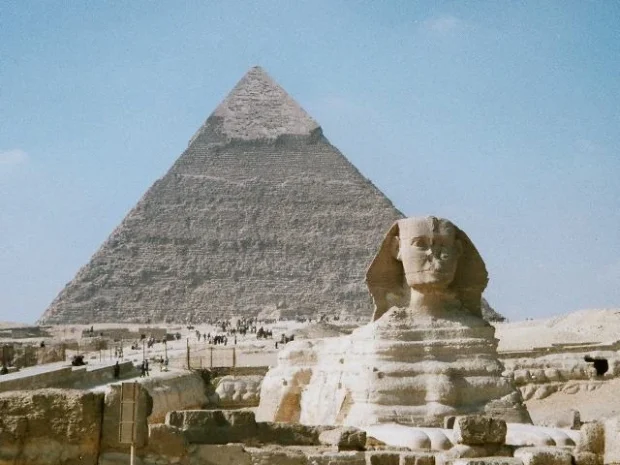Amid the eternal golden sands on the outskirts of Cairo, the Pyramids of Giza rise in quiet, timeless grandeur. These colossal monuments haunt the horizon, towering as testimony to human ingenuity and devotion long passed. For those seeking the profound quiet of history’s embrace or the solemn shadows cast by the ancient kings, this sacred site melds the pulse of Cairo with a whisper from the millennia. Understanding the Pyramids, from their place in Egyptian civilization to the present day, invites contemplation of endurance, faith, and the wisdom of simplicity. Join me as we wander these monumental slopes where earth and eternity converge beneath the unyielding sun.
Table of Contents
Approaching the Enigmatic Giza Plateau
The Pyramids sit approximately 20 kilometers southwest of downtown Cairo. The journey from the city’s heart is a passage through the hum of urban life dissolving into the arid vastness. To reach the plateau, one may take a taxi or a microbus from central Cairo’s Tahrir Square or the Ramses train station, both hubs pulsating with daily Egyptian rhythm. The ride weaves through the city’s sprawl before opening onto the desert’s embrace, where the Pyramids stand vigilant.
Travelers arriving by air find the most straightforward path via Cairo International Airport. From there, taxis or airport shuttle services can convey visitors directly to the plateau’s entrance, allowing for a smooth transition from modern transit to ancient wonders.
Nearby Accommodations and Local Fare
The surrounding area offers a variety of accommodations, ranging from traditional guesthouses to comfortable lodges that echo the desert’s tranquility. Staying near the pyramids means waking to their serene silhouettes at dawn, a quiet communion with history few can forget.
Close to the site, local eateries serve traditional Egyptian cuisine, rich with spices and stories. Sampling dishes such as koshari-a comforting mix of rice, lentils, and pasta-or freshly baked baladi bread alongside fragrant mint tea deepens the cultural tapestry woven during your visit.
Echoes of the Past: History and Reverence of the Pyramids
Born from the hands of those who sought eternal rest, the Pyramids of Giza were constructed some 4,500 years ago, standing as the final abiding places of Pharaohs Khufu, Khafre, and Menkaure. Each stone laid is loaded with the weight of devotion and myth. Their precise orientation towards the cardinal points and their relation to celestial bodies reveals a cosmic understanding as profound as the monuments’ physical strength.
Few realize the immense labor that craft these structures, drawn from quarries miles away and created without modern machinery. The ancient Egyptian civilization viewed these pyramids as stairways to eternity, gateways for the soul to join the divine in the afterlife-a belief still palpable in the silent grandeur today.
Unseen Details and Desert Secrets
Beyond the gleaming profiles of the Great Pyramid, the Giza Plateau hides lesser-known marvels-ancient boat pits that once housed solar ships meant to ferry the pharaoh’s spirit, and mysterious underground chambers carved into the sandstone. These are whispered secrets among Egyptologists, glimpses into a world where humanity touched the divine through stone and sand.
After admiring the Pyramids’ ancient artistry, a visit to the Metropolitan Museum of Art offers a journey through global creative masterpieces that echo human history.
Best Moments to Absorb the Pyramids’ Spirit
Silence and solitude are companions to the early visitor. The crisp air of morning, especially weekdays outside holiday seasons, bestows a more personal encounter with the monuments. As the sun rises, the stones glow with a warm hue, and the crowds thin, allowing one to breathe in the vastness in reflective peace.
Evening visits reveal magical silhouettes against a descending indigo sky. Yet, note that official access usually concludes before dark, reserving night visits for special occasions or licensed tour groups.
Planning Your Visit and Tours
Entry to the pyramid complex requires a ticket, purchasable at the site or through authorized vendors. To enter the Great Pyramid itself demands an additional ticket, and access is limited to preserve the ancient interiors. Guided tours are highly recommended-they unravel millennia of stories and guide you safely across uneven stones and desert sands, revealing details often missed by lone wanderers.
Reservations can be made in advance, particularly for private guides or specialized tours focusing on archaeology, architecture, or cultural heritage conservation. These curated journeys offer a layered understanding, blending scientific exploration with poetic reflection.
For official visitor information, ticket bookings, and updated guidelines, refer to the Egypt Tourism Authority’s Pyramids page.
Transport and Connectivity
The plateau is a vast stretch of desert; thus, comfortable footwear and sun protection are essential. Camel or horse rides are available and provide a traditional way to traverse the sands, though patience and caution are advised as this ancient landscape demands respect.
Within Cairo, ride-sharing apps and local taxis offer practical means to reach the plateau by day. Arranging private transport ensures flexibility and ease, especially for those carrying photographic equipment or needing extra comfort after the city’s bustling pace.
Conservation and Reflecting on Endurance
While the Pyramids have withstood the ravages of time and human curiosity, they remain vulnerable to environmental and human impact. Visiting with reverence means preserving this heritage for future souls who will come to seek inspiration beneath the same desert stars.
Witnessing the Pyramids is more than sight-seeing; it is an encounter with endurance, geology, and the spirit of a civilization that respected nature’s cycles and celebrated human possibility. They stand as a quiet narrative carved by generations, whispering the resilience of the arid sands and the wisdom of ancient hands.
After exploring the timeless Pyramids, you might enjoy a visit to Sharm El Sheikh, where Egypt’s Red Sea coast offers vibrant reefs and rich cultural tales.

- Egypt.Giza.Sphinx.01 by en:User:Hajor on Wikimedia Commons – cc by-sa 3.0
